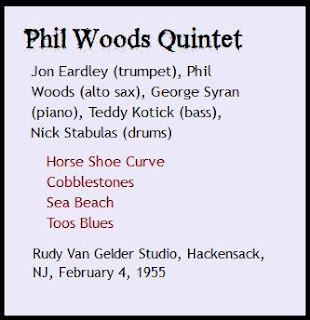And they'd have to be. Bird came from Kansas City, from Jay McShann's Kansas City blues band, and he felt the blues as only someone who grew up with the blues can. Woods was born in Massachusetts, took his first lessons from Lennie Tristano, and was schooled at Juilliard.
Like Bird, he paid his dues, but they were different dues. Juilliard and the Manhattan School of Music, where he also studied, are not for slouches. They didn't teach jazz back in those days -- did not even have a saxophone major, so he studied clarinet. But they taught a lot.
He came out of Juilliard knowing a lot, but unprepared to be thrown into the sort of apprenticeship that Parker, or John Coltrane, or Ornette Coleman would have taken for granted. He had a lot to learn, and some of it he learned from the master: Charlie Parker. Here's a story he told to Marc Myers of JazzWax about those early days:
I had just graduated from Juilliard in 1952 and was playing at the Nut Club on Seventh Ave. and Sheridan Square in the Village. After all of that great education, here I was playing "Harlem Nocturne" 10 times a night...I wasn’t happy with myself. I was saying to myself, “My god, I’m a Juilliard graduate, and I can play great jazz, and here I am playing "Night Train" and "Harlem Nocturne." I didn’t like my mouthpiece. I didn’t like my reed. I didn’t like my horn. I didn’t even like the strap.There's more than a little Parker in "Horse Shoe Curve," from the bluesy riff-based head through the blistering solos. But it, and the rest of the session, are solid Phil Woods, and once again, he and Jon Eardley sound as perfectly matched as...well, as Bird and Diz. But it seems as though Woods could match up with anyone and sound great.
...One night somebody came into the club and said, “Hey, Charlie Parker’s playing across the street. He’s jamming.” ...I was going on my break so I rushed over. When I walked in, there was this 90-year old guy playing a piano that was only three octaves long [laughs]. His father was on drums using a tiny snare and little tiny pie plates for cymbals. And there was the great Charlie Parker—playing the baritone sax. It belonged to Larry Rivers, the painter. Parker knew me. He knew all the kids who were coming up.
...I said, “Mr. Parker, perhaps you’d like to play my alto?” He said, “Phil, that would be great. This baritone’s kicking my butt.” So I ran back across the street to the Nut Club and grabbed the alto sax that I hated. I came back and got on the bandstand, which was about as big as a coffee table. I handed my horn to Bird and he played "Long Ago and Far Away."...As I’m listening to him play my horn, I’m realizing ...nothing was wrong with the reed, nothing was wrong with the mouthpiece—even the strap sounded good. Then Parker says to me, “Now you play.” I said to myself, “My God.” So I did. I played a chorus for him... When I was done, Bird leaned over and said, “Sounds real good, Phil.” This time I levitated over Seventh Avenue to the Nut Club. And when I got back on the bandstand there, I played the shit out of Harlem Nocturne. That’s when I stopped complaining and started practicing. That was quite a lesson.


No comments:
Post a Comment